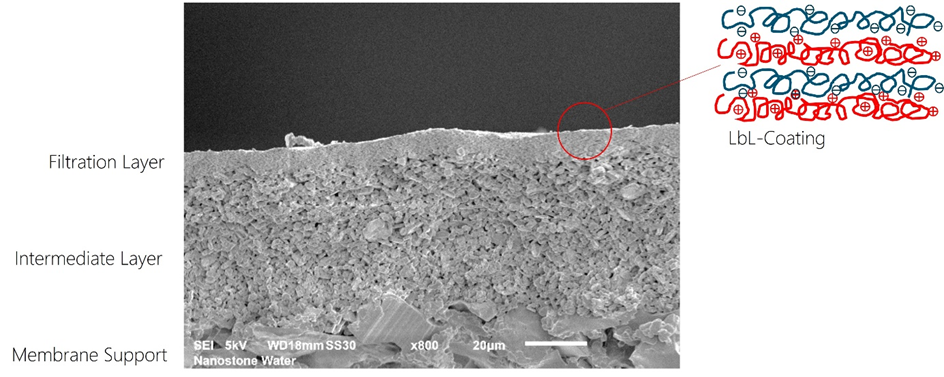Polyelectrolyte Multilayer on Ceramic Membranes for Water Filtration
- Persons involved: Robert Niestroj-Pahl (PhD Candidate), Wiebe de Vos (promotor), Hannah Roth (co-promotor, daily supervisor)
- Duration: 2022-2026
- Funding: Private Funding by Surflay Nanotec GmbH (www.surflay.com) and Nanostone Water GmbH (www.nanostone.com)
Introduction
Ceramic membranes are not as widely used as polymeric membranes for the filtration of water. The main reasons may be the higher investment costs, limited available pore sizes, and its broader pore size distribution. Today’s main use case of ceramic membranes is micro- and ultrafiltration. Very few ceramic nanofiltration membranes are available on the market now and these are very expensive due to the high energy demand and the high level of technology that is needed to produce them. The advantages of ceramic membranes are temperature stability, resistance to solvents and aggressive chemicals, long run times, and the possibility to apply higher pressures than for polymeric membranes.
With the combination of polyelectrolyte multilayers (PEM) and ceramic membranes, it is possible to combine the versatility and chemical stability of the PEMs with the robustness of the inorganic membrane. With this new hybrid membrane, it is possible to achieve a lower molecular weight cut-off (MWCO), in the range of nanofiltration and even reverse osmosis membranes.
Key words
Ceramic membranes, polyelectrolytes, asymmetric membranes, micropollutants
Technological challenges
Polyelectrolyte multilayers on ceramic membranes have not yet been studied extensively, there are few publications to be found. With these inorganic materials, other methods can be applied, for example crosslinking the multilayers with harsh chemicals or to test conditions such as extreme temperature, pH, or use of organic solvents.
Research goal
The project will evaluate the possibilities of layer-by-layer (LbL) modification of ceramic membranes in more depth, concerning a broader application range of ceramic membranes. Special attention is paid to the permeability of the coated membrane. Advanced asymmetric polyelectrolyte membrane designs will be used to enhance permeability and micropollutant retention.


